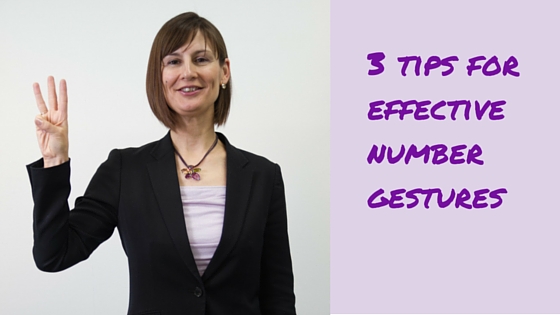You’ve probably heard that it’s good to use gestures in presentations, but maybe you feel uncomfortable and aren’t sure how to use gestures.
One easy way to get started is to use gestures related to numbers.
I’ve lost count of how many presentations I’ve seen in public, in business, and in training and coaching.
Based on what I’ve seen that works and doesn’t work, here are three tips.
Three Tips for Effective Number Gestures
1. Structure your presentation in three parts
This makes it easy for you and your audience to remember. Then use your fingers to tell the audience at the beginning that there are three parts. Introduce each part: one, two, and three, with the corresponding number of fingers.
2. Use your index, middle, and ring fingers
Different cultures use different digits to count. For some, the thumb sticking out is number one. For others, the index finger sticking up is number one. And in Japan, the thumb folded in is number one! My recommendation is to go with the index finger for one, the index and middle fingers for two, and the index, middle, and ring fingers for three. Why? Because this is unlikely to be misinterpreted, is easy to do, and is easy to see.
3. Hold your hand where it can be seen
Sometimes presenters use their fingers, but hold them in front of their body, which makes it difficult to see. Hold your hand a little to the side of your body, around shoulder height (higher for bigger venues or situations that require more energy). Make sure the palm is facing the audience – otherwise it’s difficult for the audience to see how many fingers you’re holding up.
There are lots of ways to use gestures. It’s important that you feel comfortable with the gestures, so that you can focus on the audience instead of focusing on yourself.
Then adjust the size and frequency of your gestures depending on your audience’s culture (e.g., less for Japanese, more for Italians), the presentation situation (less for serious, more for upbeat), and venue size (the bigger the venue, the bigger the gestures).
Experiment and practice to find what’s comfortable for you.
* * * * *
As a special bonus to accompany 英語の仕事術, I’ve created an audio recording of the English phrases that I introduce in the book 🙂
You can use these phrases to communicate with clarity and confidence when you’re
- giving business presentations
- participating in telephone conference calls
- facilitating global meetings
- dealing with workplace conflict.
I created this audio bonus because I know that many of you want to improve your English listening and speaking skills. By listening to these phrases repeatedly, you’ll remember them more easily.
When you can remember the English, you don’t have to worry about it. You can focus on the people you’re communicating with. That’s what’s most important for successful global business communication.


